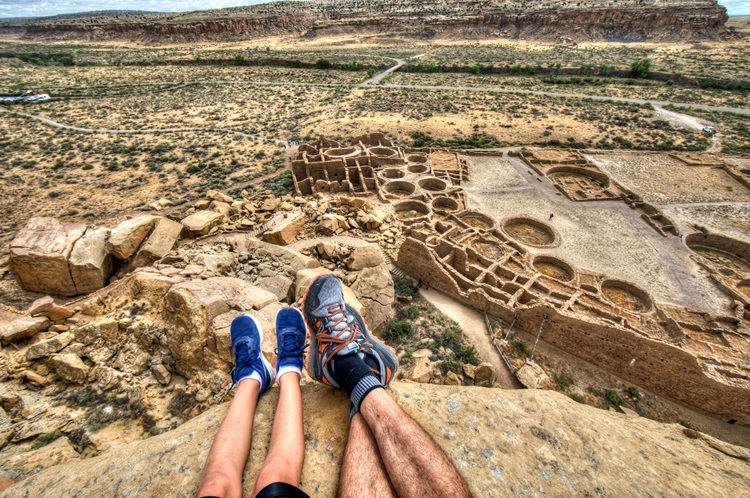
Chaco Culture National Historical Park
Chaco Culture National Historical Park, also known as Chaco Canyon, is the largest excavated prehistoric ruins in North America and is a must-see for history buffs and outdoor lovers. It is advised that visitors call the Park prior to a visit to ensure roads are accessible during inclement weather.
Turn off is on US 550 at CR 7900 Nagezzi, NM
505-786-7014

Chaco was the center of the ancestral Puebloan culture from AD 850 to 1200. Attractions within the park include Chacoan great houses, kivas, rock art, and stunning vistas. The hallmark Chacoan roads and the geometric layout of structures captivate visitors from around the world. Please call the park prior to your visit for updates on guided tours by Park Rangers and visitor center hours.
How to get to Chaco Culture National Historical Park
The remote location of Chaco Canyon adds to the beauty and adventure of visiting this National Park. The main entrance into the park is from US Highway 550. From 550 turn onto CR 7900, (40 miles south of Farmington / 50 miles north of Cuba). This route is signed from US 550 to the park boundary (21 miles). The route includes 8 miles of paved road and 13 miles of dirt road.
The section of dirt road can best be described as "washboard". Visitors not accustomed to traveling on dirt roads need not worry, note the posted speed limits, and keep in mind that the destination is well worth the 13 miles of dirt road. Please note that some roads recommended by Google, map publishers and mapping services using GPS are unsafe for passenger cars. The most recommended access point is from Highway 550, from CR 7900. The road to Chaco can become impassible in inclement weather. If rain, snow, or thunderstorms are in the forecast simply call the visitor center or visit their website for road conditions and park closures.
- Official Map of Chaco Culture NHP
- Back Country Hiking Maps
- Biking Trail Maps
- Chaco Outlier Maps
- Virtual tour of Chaco Canyon
Chaco Culture History
Chaco Culture National Historical Park preserves the monumental architecture and complex community life of a major center of ancestral Puebloan culture (Anasazi) that took root and flourished for a thousand years. The Chacoan culture began to flourish in the canyon in the mid-800s with continual habitation and building lasting for another 300 years. The ancient Puebloan people (Anasazi) constructed massive stone buildings, called great houses, of multiple stories that are much larger than what had previously been built. Construction on some of these buildings spanned decades and even centuries. These structures were often aligned to solar, lunar, and cardinal directions and placed within a landscape surrounded by sacred mountains, mesas, and shrines. The buildings in the canyon are believed to be “public architecture” that were used periodically be the people for times of ceremony and commerce when temporary populations arrived in the canyon.
By 1050, Chaco Canyon had become the political, economic, and ceremonial center for the Chacoan culture. Roads connected the canyon to over 150 other great houses, including Aztec Ruins and Salmon Ruins to the north. Chaco Canyon became the trade center for turquoise, parrots, macaws, copper bells, and other precious commodities.
By the mid-1100s the canyon began to decline as the regional center as building ceased and influence moved to Aztec Ruins and other great houses. In time, the people moved away from the area and culture to reinvent themselves. Today the Pueblo Indians of New Mexico claim to be the descendants of the ancient Puebloans.
Guided Tours
Looking for a Chaco tour guide? The following entities offer guided tours of Chaco and are recommended:
- Journey Into the Past Tours call 505-632-2013 or email sreducation@sisna.com
- Navajo Tours USA call 855-422-5476 or email tours@NavajoUSA.com
Cycling at Chaco Canyon
One way to explore Chaco Culture National Historical Park is to bike. One option for cycling is the paved one-way Canyon Loop Road (9 miles & share with vehicles). There are two backcountry options: biking to Wijiji Trail (3 miles - start at Wijiji Trailhead) or Casa Chiquita (2 miles - start at Pueblo del Arroyo parking area). This is a wonderful way to experience both the Great Houses and canyon.
For your comfort and bicycling safety:
- Wear a helmet.
- Secure bikes at the bike racks.
- Follow the rules of the road and be alert for vehicles. Please ride single file.
- Carry plenty of water and snacks with carbohydrates.
- Prepare for extreme weather. Bring along sun protection, a hat, and rain gear.
Things to do while visiting Chaco Canyon
- Hike
- Bike
- Night Sky programs
- Photography
- Guided tour by Journey Into the Past Tours
- Guided tour by Navajo Tours USA
- Self-guided tours
- Camp
Things not to do while visiting Chaco
- Do not collect pottery, arrowheads, or any type of artifact or plants
- Do not walk, climb, sit, or lean on fragile walls
- Do not deface, add to, or alter the petroglyphs, pictographs, or rocks
Videos
Farmington CVB videos also available in HD on YouTube.
Why did the Chacoans leave?
